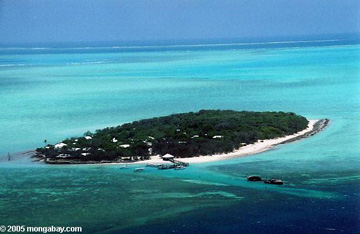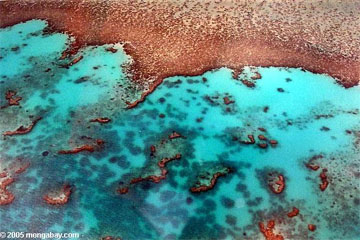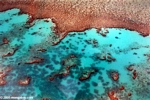The world’s coral reefs are in trouble. Due to a variety of factors—including ocean acidification, warming temperatures from climate change, overfishing, and pollution—coral cover has decline by approximately 125,000 square kilometers in the past 50 or so years. This has caused some marine biologists, like Charlie Veron, Former Chief Scientist of the Australian Institute of Marine Science, to predict that coral reefs will be largely extinguished within a century. This year alone, large-scale coral bleaching events, whereby coral lose their symbiotic protozoa and become prone to disease and mortality, were seen off the coasts of Indonesia, the Philippines, and some Caribbean islands. However a new paper in Trends in Ecology and Evolution attempts to dispel the gloom over coral reefs by pointing to strategies, and even some successes, to save them.
“We have a very good scientific understanding of what causes reefs to decline—what we now need is a clearer picture of how to help them back onto the reverse trajectory,” says lead author, Terry Hughes from the Australian Research Council Centre of Excellence for Coral Reef Studies at James Cook University.
 Heron Island: where coral reefs routinely survive cyclones. Photo by: Rhett A. Butler. |
Research has shown that coral reefs are resilient and even capable of recovering from large-scale devastating events.
For example, the authors write that “local sites on exposed reef crests on Heron Island on the Great Barrier Reef routinely lose almost all of their coral cover every decade or so because of cyclones, yet they have retained their ability to recover quickly and show no propensity to undergo a long-term shift to an alternative assemblage.”
However, human impacts have proven different from natural ones, such as cyclones. Coral reefs are no longer facing down one disaster that hits and then passes, but several different issues, which the authors call “chronic human impacts” that are on-going causing a failure “to recover from pulses of coral mortality” and eventually wholesale collapse. Unfortunately, such states are becoming increasingly common.
“Over the past century many near-shore reefs on the inner Great Barrier Reef have become covered with sediment and macroalgae, and show little or no capacity to return to their former coral-dominated condition,” the scientists write.
Hughes says, “the key to saving the reefs lies in understanding why some reefs degenerate into a mass of weeds and never recover—an event known as a ‘phase shift’—while on other reefs the corals manage to bounce back successfully, showing a quality known as resilience.”
The researchers point to a number of places where coral reefs are returning due to mitigating the human impacts that contributed to the decline. For example, ending sewage discharges in Kanehoe Bay in Hawaii has allowed coral to recover; returning populations of sea urchins in parts of the Caribbean have allowed coral to rise against seaweed; and in the Philippines better regulations on overfishing has allowed parrot fish to return, a species which aids coral by eating competitor weeds.
“The coral reef crisis is a crisis of governance, because we know what needs to be done but action (to reduce water pollution, curb greenhouse gasses and prevent over-fishing) is not being taken,” says Hughes.
 Great Barrier Reef in Australia. Photo by: Rhett A. Butler. |
The study recommends that governments integrate researchers’ understanding of coral reef resilience with policy to save coral reefs. In addition, government should educate local people, make land use changes to mitigate pollution runoff, improve laws to protect reefs, better regulate overfishing, and work with international groups, such as the Convention on International Trade in Endangered Species (CITES), to provide better protections of endangered corals.
Of course, the one big wrench in all of this is climate change. In time ocean acidification, due to increasing carbon emissions, and warming sea temperatures could doom coral reefs even when other resilience measures are taken.
To this the researchers say governments must “confront climate change as the single most important issue for coral reef management and conservation by sharply reducing greenhouse gas emissions.”
Hughes adds that, “without urgent action, unchecked global warming and ocean acidification promise to be the ultimate policy failures for coral reefs. Although it is possible to promote the recovery of reefs following bouts of bleaching via local actions such as improving water-quality and protecting herbivores, these interventions alone cannot climate-proof reefs.”
For Hughes the message is not yet gloom-and-doom, instead: “the world’s coral reefs can still be saved…if we try harder.”
CITATION: Terry P. Hughes, Nicholas A.J. Graham, Jeremy B.C. Jackson, Peter J. Mumby, and Robert S. Steneck. Rising to the challenge of sustaining
coral reef resilience. Trends in Ecology and Evolution Vol.25 No.11. doi:10.1016/j.tree.2010.07.011.
Related articles

Coral reefs doomed by climate change
(07/22/2010) The world’s coral reefs are in great danger from dual threats of rising temperatures and ocean acidification, Charlie Veron, Former Chief Scientist of the Australian Institute of Marine Science, told scientists attending the Association for Tropical Biology and Conservation meeting in Sanur, Bali. Tracing the geological history of coral reefs over hundreds of millions of years, Veron said reefs lead a boom-and-bust existence, which appears to be correlated with atmospheric carbon dioxide levels. With CO2 emissions rising sharply from human activities, reefs—which are home to perhaps a quarter of marine species and provide critical protection for coastlines—are poised for a ‘bust’ on a scale unlike anything seen in tens of millions of years.
Carbon emissions hurting coral recruitment
(11/08/2010) While research has shown that ocean acidification from rising CO2 levels in the ocean imperils the growth and survival mature coral reefs, a new study has found that it may also negatively impact burgeoning corals, by significantly lowering the success of coral recruitment. A study in the Proceedings of the National Academy of Sciences (PNAS) has found that coral recruitment could fall by 73% over the next century due to increasing acidification.
Groundbreaking research shows that rainforests and coral reefs create rainfall #BAD10
(10/15/2010) Coral reefs and rainforests seem to have little in common beyond the fact that they are both hotspots of diversity, yet groundbreaking research is showing how these different ecosystems—when intact—may actually seed clouds and produce rainfall.
Colossal coral bleaching kills up to 95 percent of corals in the Philippines
(09/23/2010) It is one of the most worrisome observations: fast massive death of coral reefs. A severe wide-scale bleaching occurred in the Philippines leaving 95 percent of the corals dead. The bleaching happened as the result of the 2009-2010 El Niño, with the Indian Ocean and Southeast Asia waters experiencing significant thermal increase especially since the beginning of 2010.

Coral reef survival depends on the super small, an interview with Forest Rohwer
(08/30/2010) If you take a teaspoon and dip it into the ocean what will you have? Some drops of lifeless water? Only a few decades ago this is what scientists would have said, however, the development of increasingly powerful microscopes have shown us a world long unknown, which has vital importance for the survival of one of the world’s most threatened and most treasured ecosystems: coral reefs. A single milliliter of water is now known to contain at least a million living microbes, i.e. organisms too small to see without a microscope. After discovering their super-abundant presence, researchers are now beginning to uncover how these incredibly tiny life-forms shape the fate of the world’s coral reefs.
Massive coral bleaching in Indonesia
(08/16/2010) A large-scale bleaching event due to high ocean temperatures appears to be underway off the coast of Sumatra, an Indonesian island, reports the Wildlife Conservation Society (WCS).

The biology and conservation of declining coral reefs, an interview with Kristian Teleki
(08/15/2010) Coral reefs are often considered the “rainforests of the sea” because of their amazing biodiversity. In fact, coral reefs are one of the most diverse ecosystems on earth. It is not unusual for a reef to have several hundred species of snails, sixty species of corals, and several hundred species of fish. While they comprise under 1% of the world’s ocean surface, one-quarter of all marine species call coral reefs their home. Fish, mollusks, sea stars, sea urchins, and more depend on this important ecosystem, and humans do too. Coral reefs supply important goods and services–from shoreline protection to tourism and fisheries–which by some estimates are worth $375 billion a year.